Players combine pick up and deliver with elements of combat and exploration to save their kingdom
20 min per player
Designer: Eric Geller, Shannon Geller
Publisher: Short Hop Games
We’re always excited to review games from new up-and-coming publishers and designers, and Quests & Cannons is a great example of both! Clearly a labor of love from newbies Eric Geller and Shannon Geller, Quests & Cannons is a solid debut entry for them into the world of board game design and publishing.
Set in the mythical world of Miraheim, players are Champions sailing among newly formed islands to complete quests, racing and fighting other nations to rule the sea. This medium-light game combines pick-up and deliver mechanisms with solid worldbuilding to create an interactive, versatile, and approachable game fit for broad audiences.
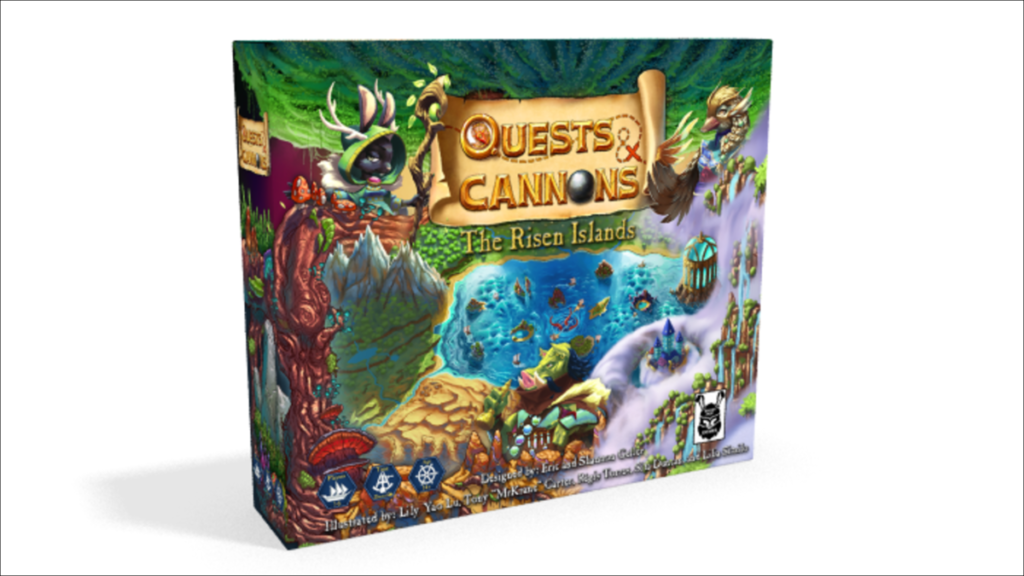
Note: Short Hop Games provided us with a pre-release prototype copy of the game for review prior to the Quests & Cannons Kickstarter launch on September 21, 2021 (pre-launch page here). This is a subjective review based on our experiences playing the prototype (see our review policy HERE).
While the game is mostly finalized, some minor elements such as the look of components or the layout of the rulebook may change between the time of this review and the final game. The images we took below show prototype components and boards that are subject to change.
Gameplay Overview
This is a general overview to provide context for the review, not an in-depth how to play. Some rules may be glossed over or missing.
Game Flow
Quests & Cannons is a very straightforward action selection, pick-up and deliver game with elements of exploration and combat. The game has a ton of variability in modes and can be played as a free-play, in teams, solo, co-op, or with an “AI” (more on that later). In Quests & Cannons, players take turns until a point threshold is reached based on number of players & mode, which triggers the end of the game.
Set Up
Once players have chosen their mode (e.g. free-play), they construct the map by laying out the tri-hex island tiles, trading posts, and distributing the island feature tokens (resources). This can be done using the recommended layouts in the rulebook or by creating a random layout.
Pro Tip: We recommend sticking with the island layouts in the rulebook for a more balanced experience.
Once the central board is set up, each player chooses a champion character and sets up their player board area. The prototype we played with had a fancy double layered player board in the shape of a ship with slots for the champion board, cannons, sails, cargo, and dice. Players begin the game with 3 coins and 5 ammo dice. They also configure their board specific to their character’s starting sails, cannons, and available cargo slots.
In turn order, players select a starting space and draw a map clue.
Pro Tip: Check your setup and if you are not using all 18 islands on your map, remember to remove the map clues for the islands that you aren’t using.
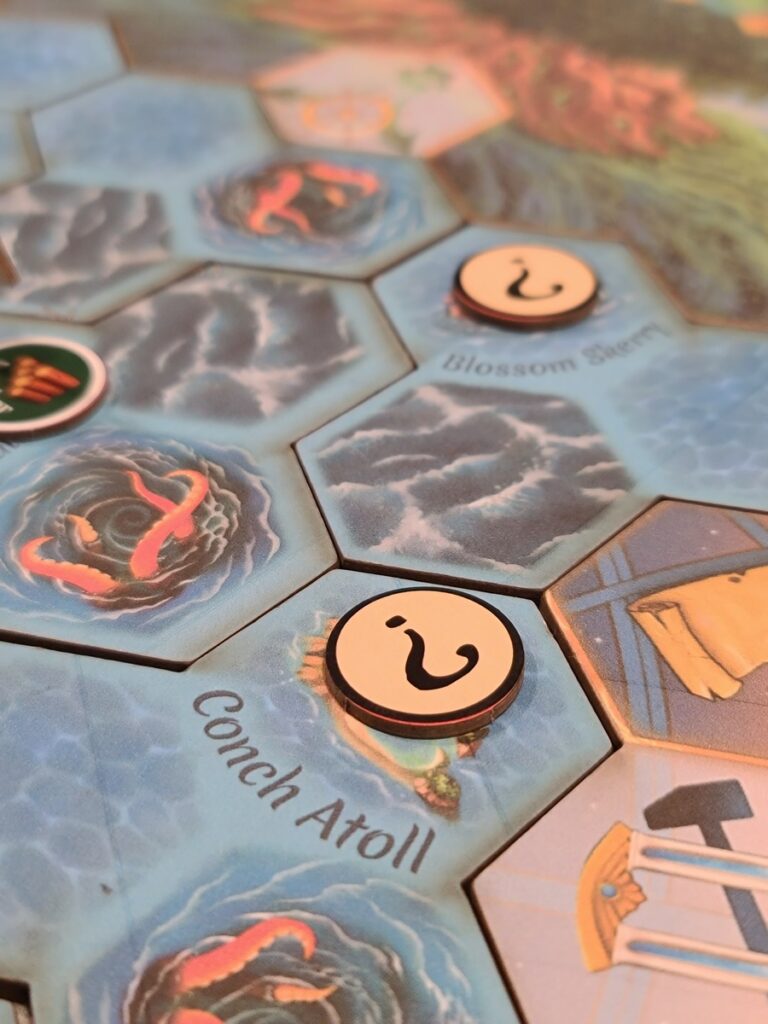
Terrain Types
The central map has many different types of sea and stops your ships will travel through.
- Seas
- Calm sea – no barrier to movement action
- Treacherous seas (fight the kraken) – roll the blue traveler’s die
- Rolls 1-3 = 1 damage + spend action point to move out of the treacherous seas
- Gain a +1 for a future treacherous sea roll
- Rolls 4-6 = success + free movement into any adjacent space
- Rolls 1-3 = 1 damage + spend action point to move out of the treacherous seas
- Stormy seas – count as two spaces
- Outpost/Trading Post/Starting Spaces
- Free actions (see below) and resolving quests
- Islands
- Explore the island
- Gather resources
- Gain Quests
Turn Structure
Each turn players have three action points available to them to do any of the three available actions. All actions cost one action point, may be done in any order, and may be repeated (e.g. you may move twice and gather, or move three times, etc).
Available Actions
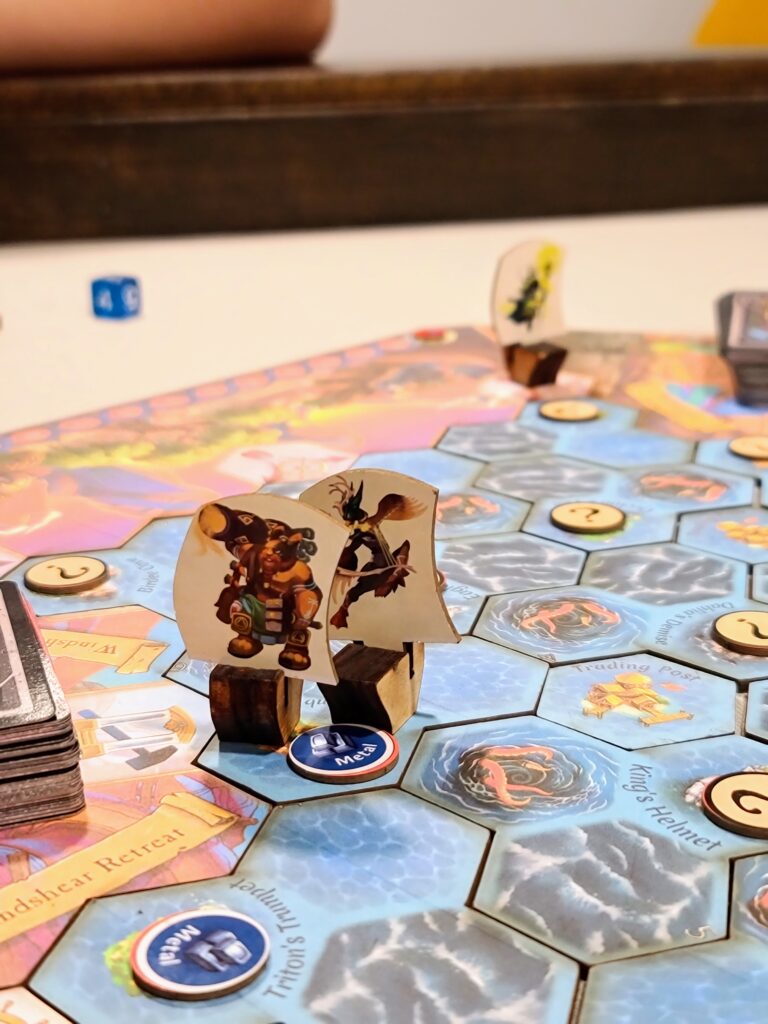
- Move: Move one space in any direction
- Flip available sails over on your player mat for +1 movement
- Gather: Pick up one resource of the island you’re on
- Attack: When sharing a space with an opponent’s ship. Roll 1 black ammo die per available cannon. Each cannon can only be used once per turn and refresh at the start of the next turn.
- 4 pips (dots on die) = 1 damage (no defense mechanism)
- Gain 3 prosperity (points) for sinking an opponent ship
- Lose all ammo dice used
- Sunk ships lose their goods, one ship equip, and half their coins. They then re-spawn with 5 ammo dice on their start space.
There are also many free actions depending on the space you end your movement on, described below.
Free Actions
There are a few other free actions that can be played depending on the type of space players end their movement:
- Trading Post:
- Trade goods for coins, goods for other goods, or purchase goods
- Repair damage to your ship
- Outpost:
- Upgrade your ship (spend goods and coins to add sails, cannons, cargo spaces)
- Buy ammo dice
- Sell resources, loot cards (rather than using their ability), or map clues
- Starting Space:
- Players can only enter their own starting space
- Repair their ship
- Buy Ammo dice
- Sell resources, loot cards, map clues
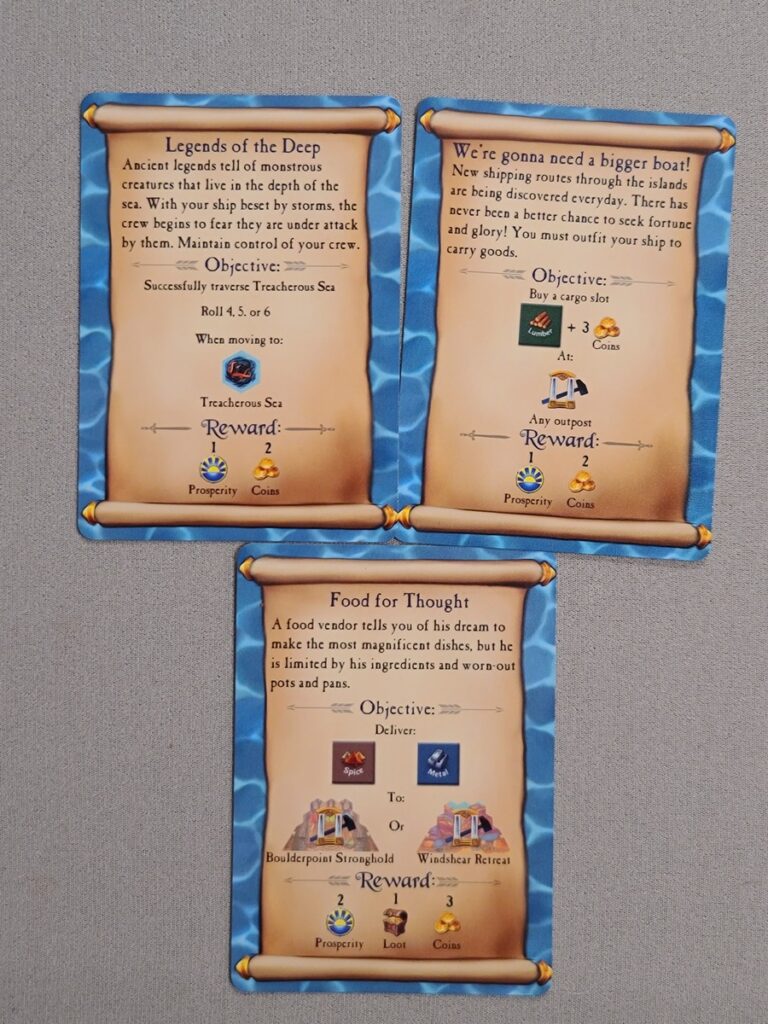
Quests
Quests are the pick-up and deliver missions players gain when they end their movement at any island. Each quest card tells the player what to do and where they need to go to complete it. Completing a Quest is a free action and doesn’t require spending an action point.
- Possible rewards: score points, gain loot cards, ship upgrades, and/or coins
Unique to us: we found this was our primary method of gaining points since we are typically conflict/combat avoidant players
Loot Cards
Loot cards are either “purchased” with resources or gained through completing quests. There are two types of loot cards:
- One-time use abilities
- The card says when it can be used, for example “on your turn…”
- Ship equips = long lasting abilities
- Creates a little “mini engine” that can, and should influence your decision making in future turns
- Can only equip two at a time
- Fun to say out loud
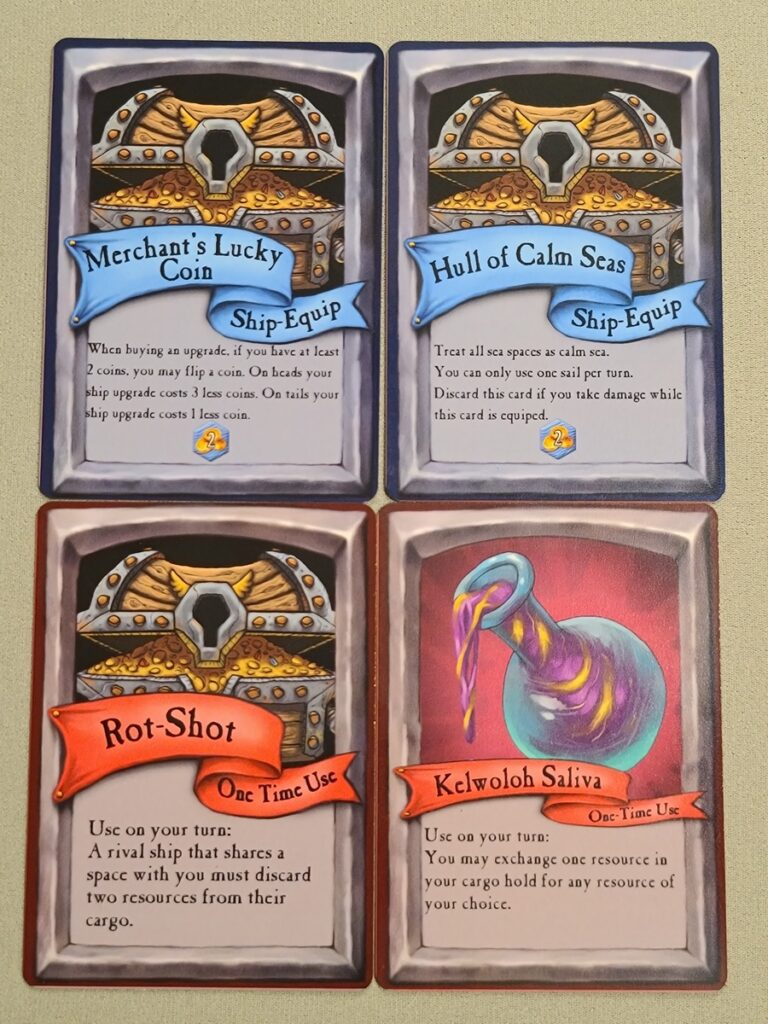
Map Clues
Map Clues are cards that give some direction in the early game. Complete Map Clues at the indicated island for either 1 point or a Loot card. Completing Map Clues is a free action. Completed map clues can be traded in at the start space for coins
End Game
The free-play mode (every player for themselves) is essentially a “race” game in that the first player to 15 points wins. Teams mode is similar, where the first team to reach a combined score of 20 (teams of 2) or 25 (teams of 3) wins.
Alternate Modes
This game is super versatile, with a bunch of different player modes to keep it fresh each time.
- Free-play: This is mostly described above, but is the typical every player for themselves style of play.
- Teams: 2v2, 3v3, 2v2v2
- The two biggest differences are that players may trade with each other for free when they’re in the same space and they contribute to a single combined score
- AI: can be used with co-op and solo modes (below)
- Add in 3 “AI” ships (easy) or 4 ships (hard) from hte leftover champions
- AI ships have starting health of 5 and 2 cannons, use leftover champion boards to track
- At the end of a player’s turn, check for an AI attack: if they are within the movement points for that AI Champion (# cannons=movement points), the AI moves to them and attacks
- Players can sink AIs for coins and 3 points, but the AI re-spawns with full health and an extra cannon (up to 4 cannons)
- Co-Op: Players work together against the AI
- Similar to teams in that players can trade and combine their points
- Add in a round count-down clock. Players only win if they reach a combined total of 20 points before 15 rounds are over.
- Solo game: Same as Co-op with AIs, just without teammates and you only need to score 15 points in 15 rounds to win
What do we think?
For a relatively light weight game, there is a lot going on! Games in this category are more fun when there’s a little something for everyone, and Quests & Cannons has a little of everything. A bit of pick-up and deliver, some attacking, some action selection all set against a vibrant worldbuilding background. We did find that there were a few things that didn’t work as well for us, but overall this is an excellent debut game and makes us very excited to see what else these designers create!
What did we like?
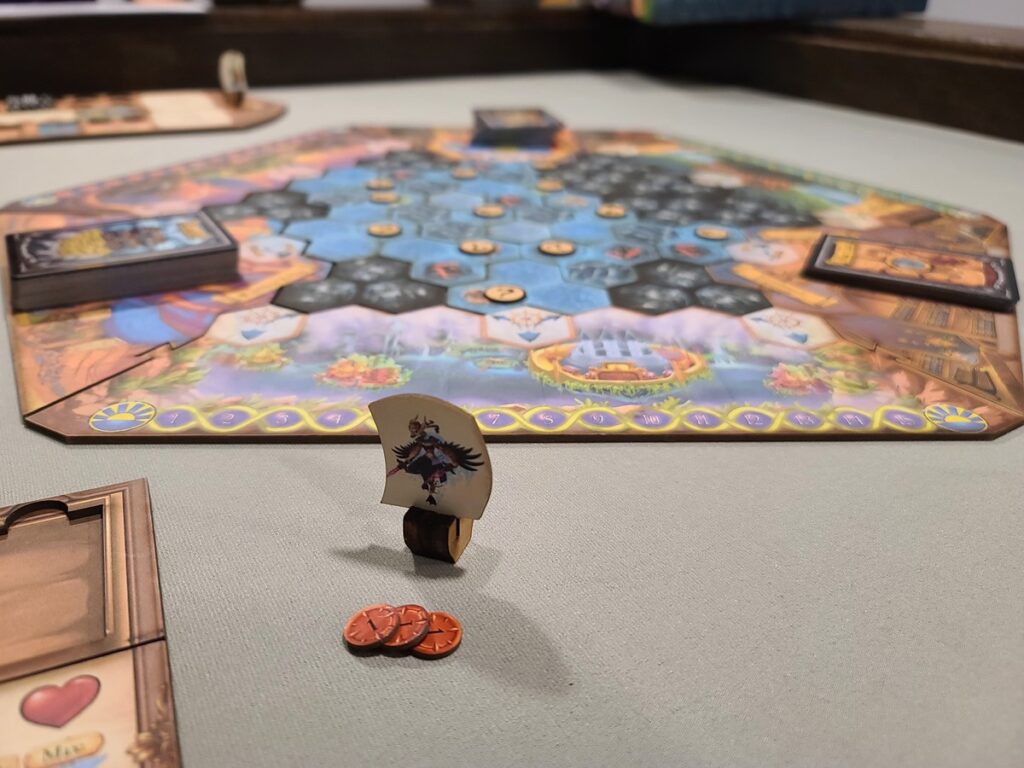
We’ve already mentioned the artwork a few times, but it truly is well done, and speaking with the designers there’s even more to come for this world that we’re excited to see. The art on the game transports players into the mythical world of Miraheim and the components and mechanisms feel purposeful within the story. As you play, you can see the connection between the game mechanisms and the story.
The pick-up and deliver mechanism is also strong. The rewards are interesting, and one of our favorite parts of the game was when we got “unique” quests that had us do something (rather than straightforward delivery) like upgrade our ships or fight the kraken. The unique abilities on the Loot cards could be super cool too, and the flavor text on each card type was always fun to read.
The choice between free-play, team play (2vs2 or 3vs3), co-op, or the addition of an AI contributes to a lot of re-playability. The board will also be different every time, and there’s a possible variant where players draft the board set up that we didn’t get a chance to try but sounds super fun. The flexibility in both the number of players and the available modes is super interesting and definitely gave us a feeling of “we want to try that next” that kept us coming back to the game. Out of all the variations on modes we tried, the free-play 2-player with the addition of the AI was our favorite.
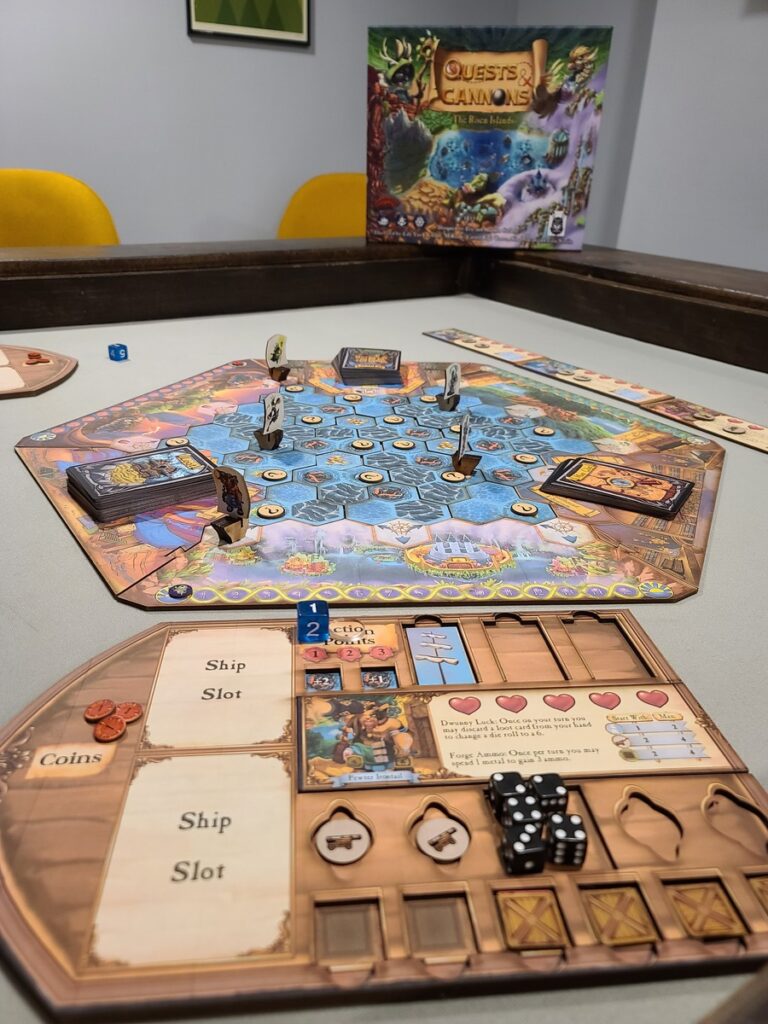
What didn't we like?
In general, we find games with strong pick-up and deliver mechanisms are better at more than two players, and the free play version of the game wasn’t great at the lower player count. It got pretty long for us, perhaps because we both tend to go for things like completing quests over attacking each other unless combat is more central to the game. This is hugely improved by playing 2-player with the AI (aka “bot” players) either as a team against the AI or everyone for themselves. The AI is tough, but in a much-needed way that adds both complexity and some tension to a game that otherwise is a bit drawn-out at lower player counts.
We also think the set up was complicated compared to the overall weight of the game. Gameplay itself is very approachable and straightforward once you get into it, but someone looking for a lighter game might get intimidated by the many rules and intricate setup. We played with a prototype, so minor changes to the rulebook and possibly some components will help with this.
Who will like this game?
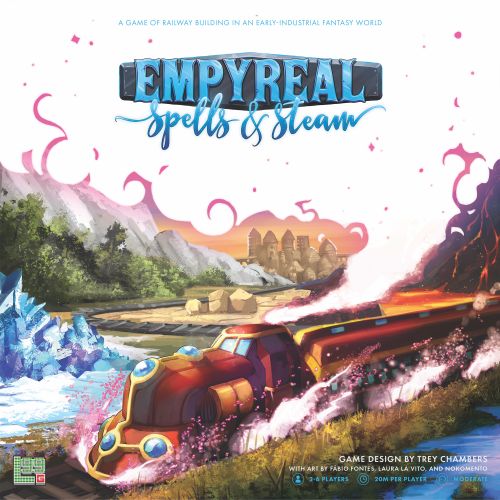
This is a great fit as a lighter strategy game good for a wide audience. There seems to be a ton of choices to make with all the different terrains and locations and card types, but the map clues and quests usually help clearly define the “best” path forward in a given turn to make an otherwise potentially overwhelming game a lot more approachable. Players can choose how much planning ahead they want to do, which evens the playing field a bit for a wide range of experience, ages, and board gaming interests.
Once you get into it, gameplay is very straightforward with the source of tension being other players’ attacks, so more experienced gamers will want to play at higher player counts or really push it with the advanced AI mechanism.
Anyone who likes pick-up and deliver games like Empyreal will likely enjoy this game.
Sarah's Take
Quests & Cannons is an attention grabber! The art and table presence immediately drew me into the game, however, I would go as far as saying that the table presence out-shines the game play for me. There are some really interesting pieces here that just didn’t come all the way together for me, personally.
I found the Loot cards to be a ton of fun and probably my favorite part of the game. I loved timing the use of one time abilites to make an epic turn. The ship equip Loot cards are more rare in the deck, but I really enjoyed the purpose and direction these upgrades gave to my game plan.
Conversely, the need to use sails, and thus flip sail tiles, on every turn created a frustratingly fiddly experience for me. I pretty much used as many sails as I could on each turn to maximize other precious, limited, actions. The sail tiles sit in the awesome little slots on the dual layered player board but flipping and resetting them each turn was cumbersome and felt like a chore. Cannons, work similarly to the sails but I did not engage in attacking often enough for it to bother me quite as much.
Emily's Take
I generally enjoy pick-up and deliver games more than Sarah, and this one had a lot of great qualities. The theming is fun and interesting, and I definitely enjoyed the asymmetric abilities and flavor/background text that is part of the worldbuilding.
I do personally prefer there to be some sort of defense mechanism to accompany attacking mechanisms as I don’t like the feeling of helplessness when your ship is being bombarded. A lot of similar games are built this way, but it is always tough to watch your ship sink (AI’s can be brutal, y’all) and have no way you could have stopped or prevented it. Some loot cards might lend a hand, but there is no built-in mechanism to stop someone from inflicting damage.
The AI was brutal, but in the best way. The AI mechanism is tough but takes the game up a notch at 2-player. Co-op and the teams modes (at higher player counts) were really cool too, and trying the different modes almost felt like a new game each time.
Overall I thought it was a solid game, especially for first-time designers and I’m excited to see what they create next!
Breakdown
First Play
As we said above, the setup makes the game seem a bit more complex than it is. The designers have a bunch of great ideas to address this, so we’re confident it will be vastly improved by the time it hits most people’s tables. Overall we got the hang of it very quickly and were able to jump in and have a great, competitive game right away.
Subsequent Plays
There is a bit more strategy to layer in once you have a play or two under your belt, and there are definitely ways to improve efficiency in getting points. The game itself didn’t change much for us from early plays to later plays, since there are really two primary mechanisms for getting points: attacking or Quests. Map clues also give points, but that is more rare (when we played) and have a smaller point value.
What was really fun to try out in later plays were the different “modes” of play. We started with free-for-all to get a feel for the game mechanisms, but found that teams, co-op, and throwing in the AI (at 2 player), were by far our preferred modes and feel very different from each other.
Parent Perspective
Interruptions
This game was pretty interruption-friendly. With your quest cards and map clues you usually have an immediate reminder for what you were going to do, and even if you lost your train of thought it’s pretty straightforward to find another one that works as well.
The caveat is if you’re attacked while you’re getting the kiddo their bedtime cherry tomato, you might miss witnessing all the damage that was done to you. Or maybe that’s for the best…
Time Investment
This tended to run long for us. At 2 players the estimate was ~40 min, but our games often took closer to an hour (even accounting for a million kiddo interruptions). Setup and takedown is also fairly time consuming because of all the pieces.
Life Fit
This would work better as a weekend game or one to play while the kids are at nanna’s.
The publishers also define the age range as 14+ (probably because of the bit of violence?), but this is a game that could probably be played at parents’ discretion with younger kids (and a helping hand).
Rating
6/10
Quests & Cannons is on the lighter side of medium weight, which is a HUGE, competitive space to be, so it’s tough to stand out. We did like the game and it makes us very excited to see more work from these designers, but there’s also some drawbacks that mean we will more likely choose other similar-weight and feel games over this one. Despite that, we do believe this game will have a ton of fans. The art is stellar and worldbuilding is interesting, and the game does an excellent job of matching the worldbuilding with the game mechanisms to create an immersive experience.
*See our rating scale HERE
Click through for more posts, or follow us on social media to see what we’re playing and for new post updates!
